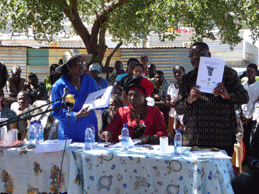
The Shack Dwellers Federation of Namibia (SDFN) has released a profile of informal settlements in Namibia.
The report is part of the Community Land Information Program (Clip), the national information gathering activity of low-income people living in informal settlements and backyards throughout Namibia.
It found that up to 25 percent of Namibia’s 2 million people live in informal settlements, a significant challenge facing urban development.
Another major concern is the sanitation situation; 33 percent of households profiled use open air toilets, while half of the informal settlements have no toilets.
For each of the 13 informal settlements in Namibia that were profiled, the report outlines the locality and general description; land tenure and ownership arrangements; settlement and population size; the estimated number of households; basic amenities; education, health and other social services; transport infrastructure and other public services; people’s involvement in development activities; and contact information of community representatives.
Since gaining its independence in 1990, Namibia has experienced rapid urbanization that has resulted in the spread of informal settlements. Local and national authorities lack the necessary information about those communities in order to incorporate them into urban planning.
In order to fill this gap, the slum dwellers conducted the first step of Clip, namely profiling their communities. They were supported in their efforts by SDFN and in partnership with the Habitat Division of the Ministry of Regional and Local Government, Housing and Rural Development (MRLGHRD), Namibia Housing Action Group (NHAG), the Habitat Research and Development Centre (HRDC) and Shack/Slum Dwellers International (SDI).
The profiles are expected to pave the way for a complete shack and household registration, which will form the basis of settlement upgrading and serve as a tool for securing land tenure for low-income households.
Recently, the Slum Dwellers International (SDI) and Pamoja Trust released the Nairobi Inventory, a similar list of informal settlements in the Kenyan capital.




